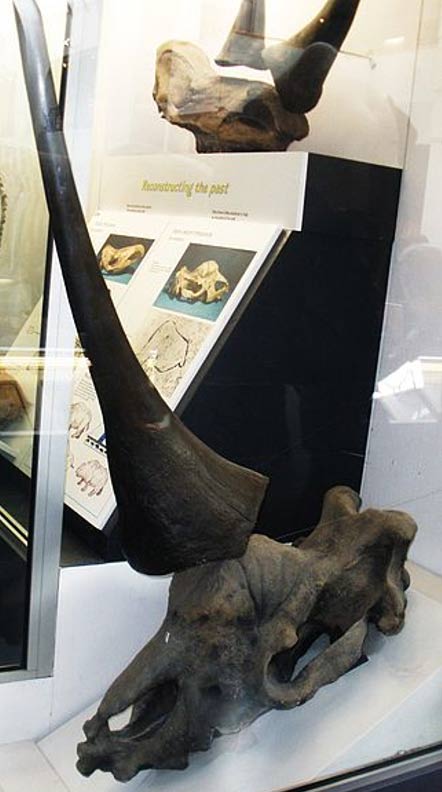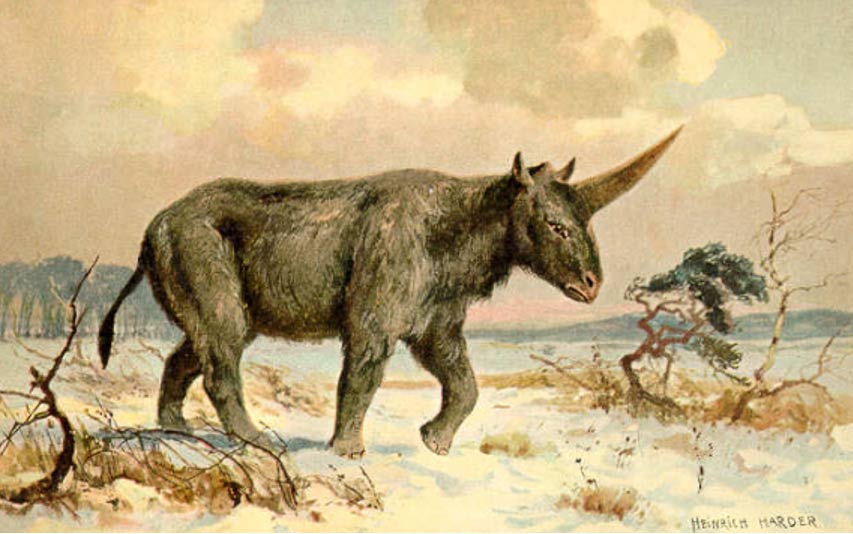Researchers Find Siberian ‘Unicorn’ Fossil Fragments in Kazakhstan, Say Creature Lived Much Longer Than Thought
By Epoch Newsroom / The Epoch Times
Researchers have found fossil fragments that indicate the so-called Siberian Unicorn last walked the Earth a mere 29,000 years ago.
The updated timeline is a huge jump since scientists thought the creature died out around 350,000 years ago.
About 20 fossilized mammal teeth and bones were found in Kazakhstan.

Side view of skull and reconstructed horn of a Siberian ‘Unicorn’ (public domain)
Siberian Unicorns did have a horn on their heads. The actual creature’s head, though, stood between the horse and rhinoceros families, according to early descriptions of the animal published in the journal Nature in 1878.

First published restoration of Elasmotherium sibiricum, by Rashevsky under supervision of A.F. Brant. (Public Domain)
The noses of the creatures were much narrower than that of the rhinoceros, though, while the eyes were larger. The creatures likely had a shaggy coat of hair.
- Bestiary, The Book of Beasts: Compendiums of Medieval Monsters and Moral Lessons
- The Extensive Indus Valley Sites of Gujarat

Artist’s impression of an Elasmotherium sibiricum (public domain)
The newly discovered skull fragments have left researchers convinced that some members of the species survived for hundreds of thousands of years longer than previously thought. Radiocarbon dating shows the age of the fragments, the researchers said in a report published in the American Journal of Applied Sciences.
The skull fragments–about 20 fossilized mammal teeth and bones–were found in Kazakhstan.

Pair of E. sibiricum (the Siberian ‘unicorn’). (public domain)
Featured image: Heinrich Harder's painting of the so-called Siberian Unicorn. (Public Domain)
The article ‘Researchers Find Siberian Unicorn Fossil Fragments in Kazakhstan, Say Creature Lived Much Longer Than Thought’ by The Epoch Times Newsroom was originally appeared on The Epoch Times and has been republished with permission.


















Comments
It's crazy to think that this kind of creature really existed, even if it seems closer to the rhinoceros than to the horse...
https://kawaii-unicorn.com
Finally! Now that a UNICORN fossil is found, maybe practical common sense would reveal that - like the Rhinoceros; Unicorns were hunted for their horns; eventually to be extinct. This would not have been for physical purpose at that time but for mystical uses instead.
If these creatures died during the mass extinction at the end of the Pleistocene, then the unicorn of legend may well be a folk memory of them. Native Americans preserved a clear memory of the mammoth and mastodon. In the same way, it is becoming increasingly clear that troglodytes and satyrs of Greek legend were remnant Neanderthal populations.
Oh. Unicorns are real. Cool.
the oldest Centaur myths were probably about the original PIE people. Centaurs lived in Scythia (aka the Russian steppe and Asia Minor) and some of the older myths actually said they were horseman who spent so much time on the horse it was as though they were one and the same.
Pages